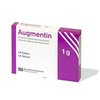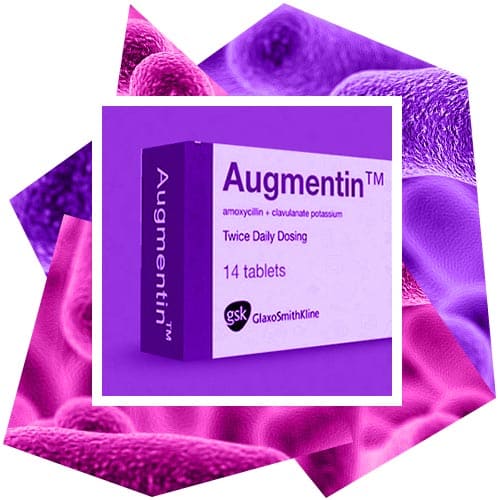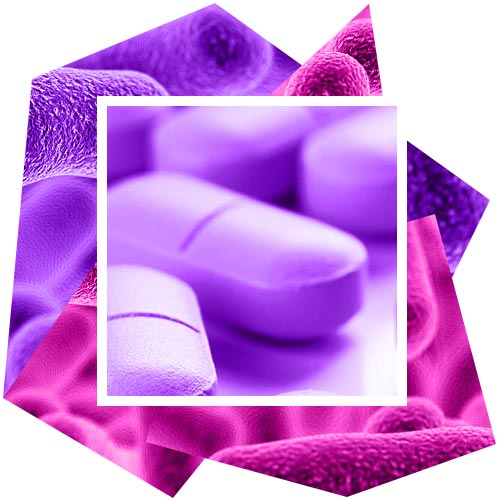Augmentin
Drug Overview:
Augmentin is a broadly used drug which usually come in the market as a powder for suspension. Astonishingly the drug also comes as chewable tablets and simple tablets.
From the structural and the natural point of view this drug is a antibacterial drug which is specifically administered through oral route.
The drug itself is a combination of amoxcillin and beta lactamase inhibitor.
To study the drug more deeply in terms of its structural composition augmentin is a modified form of what ampicillin but isn't that similar to it whether it is in terms of actions or structural basis. The drug originates from the penicillin nucleus specifically 6 aminopencillinic acid. The Molecular weight of the drug is almost 419.46. Now along these components the unit present in its making is clavulanic acid. Now this clavulanic acid is produced from the fermentation of S.clavuligerus. These units are somewhat structurally related to penicillin and have this ability to disable the beta lactams when they inhibit the active sites occupied by the enzymes.

Inactive Ingredients:
The ingredients of the drug varies according to the type of drug given The inactive ingredients in the tablets are as follows:
Tablets:
- Colloidal silicon dioxide, hypromellose.
- Magnesium stearate, microcrystalline cellulose.
- Titanium dioxide.
Each tablet of augmentin is known to contain a total of 0.63 of the potassium.
Powdered:
- colloidal silicon dioxide, flavorings, xanthan gum and manitol is used along with aspartame.
Chewable tablets:
It is similar in composition as compared to both tablet and powdered form of the drug.
- Colloidal silicon dioxide, flavorings as well as mannitol.
Indications:
In order to reduce the chances of drug developing some resistance against augmentin and to maintain its long term effectiveness it is advised that they should be strictly taken when the prognosis of the disease is given to be solely due to a bacterial attack. When the diagnosis is made the product too can be modified with respect to the needs. In the absence of advanced diagnostics it is advised to study the epidemiology and then suggest a suitable therapy. Some agents of augmentin might lead to the following diseased conditions;
- Lower respiratory tract infections are caused by beta lactamase which are responsible for the production of Morexlla and Influenza.
- Bacterial otitis is also caused due to the agents described above and their production is supported by beta lactams.
- Sinusitus is also caused by Moraxella and influenza
- skin infections are caused by Staphylococcous aureus and E.coli.
- Urinary tract infections are also caused by E.coli brought about by beta lactams and enterobacter species as well.
- If in any case during diagnostic tests if any agent present in the composition of augmentin is found to be supportive of any diseased condition the use of augmentin should be cut down entirely so as to avoid any further complications. Overuse of these drugs might also lead to bacteria being resistant to them thus rendering a poor or no effect to the agents attcaking the body.
Usage:
Augmentin is usually taken without keeping in mind the time of last meal. But in order for the proper absorption of the potassium present in augmentin it is taken prior to the meal inorder for it to absorb more efficiently and act effectively thereby reducing the infections of GIT tract.
Adults:
The dosage in adults is divided into two specific timings according to the dose that is to be taken. A 500mg augmentin should be taken every 12 hours while the 250mg dose should be taken at every 8 hours. In case of infections of the respiratory tract it is advised that the dose is taken 875mg after 12 hours and 500mg every 8 hours. Adults who face difficulty in swallowing the tablet should be given suspension or powdered form of augmentin. For suspension form of the tablet it is supposedly given at 125mg/5ml or 250mg/5ml. Both of these are taken in the replacement of the 500 mg tablet. In case of replacing the dose of 875mg 200mg/5ml or 400mg/5ml is given. It should be noted that when administering the drug the suspension form shouldn't be doubled. For instance the 250mg/5ml if doubled wouldn't contain 500mg of the tablets.
In the case of chewable tablets the case still applies and they can't be replaced with the 250 mg of the tablets even if they also contain the same amount. This is due to the difference of potassium content present in the dose given and any change would render lesser effect. In case of the tablet having a dose rate of 250mg the content of clavulanic acid is 125 mg and in the case of 250 mg of chewable ones it is 62.5 mg.
Pediatric patients:
Augmentin should be given to the children who are above 3 months of age if any bacterial attack occurs. For infants the dose is set to be 30mg per day which is also divided on 12 hours. Use of 200mg/5ml is not widely practiced but the use of 125mg/5ml is recommended. Though these are given in the alarming bacterial attacks but they can also prove to induce diarrhea to some extent. The patients who are weighing 40kg or more are given dosage keeping in mind the dosage given to adults. However a 250mg tablet should not be administered not unless the child is of 40 kg or above.
In case of renal impairment:
Patients who have renal impairment problems are not offered reduction not unless the impairment is known to be severe. A dose rate of 875mg in the patients who have renal impairment is not recommended. Those who have a glomerular filtration rate of 10 to 30 mL/min can be given dose of 500 mg or 250 mg every 12 hours depending on their condition. Those who have a glomerular filtration less than 10 mL should be administered 500 mg to 250 mg every 24 hours depending on the infection considering how severe it actually is. Patients receiving hemodialysis should also be given dose of 500 mg to 250 mg every 24 hours. An additional dose can also be administered prior to and after dialysis.
Side effects:
The drug is known to have adverse effect on the body therefore the use of the drug is done when there is no other replacement available.
Mainly it effects and causes the following reactions.
- GIT infections
- Hypersensitivity reactions
- liver
- renal
- hemic and lymphatic systems
- CNS
These are discussed as follows
GIT infections:
The drug might cause gastritis, stomatitis, black hairy tongue and entercolitis. The drug if taken without following a proper prescription might also induce diarrhea.
Hypersensitivity reactions:
Puritis, angioedema and serum sickness reactions may also be triggered due to augmentin. Arthritis too is known to happen as a part of adverse reactions of these tablets. Vasculitis is also observed.
Liver:
Dysfunctional liver which can include jaundice and hepatitis. Increase in AST and ALT is also seen. Liver associated conditions are reported in people who are older and have been treated with augmentin for a long time. The biopsy performed on liver also show the changes in the hepatocytes. Due to the hepatic dysfunction deaths have been reported and is considered to be a condition which is irreversible.
Lymphatic systems:
Different types of anemia has been reported so far including hemolytic anemia and thrombocytopenia. Thrombocytosis was noted in 1% of the patients. Diseased conditions linked to lymphatic system can also lead to death if not treated properly.
CNS:
Convulsions, anxiety, behavioral changes with some sort of depression and insomnia might just be induced by the usage of augmentin.
Additionally, tooth discoloration is also reported and mostly are known to occur in children. However the discoloration can be reduced or eliminated by proper brushing of teeth. If administered to pregnant women a significant decrease in the concentration of estradiol is noted as well. Given in labor can also prolong the time of labor thus can cause complications during the delivery. It should be noted that the drug is known to pass through the mothers milk and thus can cause some adverse effects in the infant. It is therefore recommended not to administer the drug to the mother when nursing period begins.
Augmentin acts as a good suppressing agent against bacterial infections given the fact that the infections are strictly bacterial in nature. If they are administered without any diagnosis the bacteria can become resistant to it thus rendering it useless every time it is administered. Given a long term use in adults it can lead to insomnia or sleep deprivation thus effecting drastically on one's health along with multiple disorders related to the CNS like anxiety depression and might as well lead to OCD. It should be noted that the drugs should be used with a complete follow up plan with the physician or taking it without prescription would lead to substance abuse and might cause death even. The safest dosage rate is 250 mg but consultation with the physician is recommended.

Antibiotics
Antibiotics or else known as the antibacterial, are medications which are used to slow down or completely destroy the growth of bacteria. All the antibiotics are used in order to cure diseases which are caused by bacteria. Antibiotics are not made for the treatment of viral infections such as cold, flu and cough. However, for all sorts of bacterial disease antibiotics are very effective but they also have potential side effects as well. This article will explain almost all the facts, potential side effects and resistance with which they provide to the body.
Antibiotics were discovered by Alexander Fleming in the year 1928. He discovered antibiotics in the form of penicillin and laid the foundation. However, these antibiotics are not able to fight viral infections. Fleming was very much accurate in predicting the rise of antibiotic resistance and the fact that antibiotics kill or slow the growth of bacteria. There are side effects of antibiotics as well which include diarrhea, upset stomach or nausea.
Usage:
Antibiotics is usually taken without keeping in mind the time of last meal. But in order for the proper absorption of the potassium present in Antibiotics it is taken prior to the meal inorder for it to absorb more efficiently and act effectively thereby reducing the infections of GIT tract.
Adults:
The dosage in adults is divided into two specific timings according to the dose that is to be taken. A 500mg Antibiotics should be taken every 12 hours while the 250mg dose should be taken at every 8 hours. In case of infections of the respiratory tract it is advised that the dose is taken 875mg after 12 hours and 500mg every 8 hours. Adults who face difficulty in swallowing the tablet should be given suspension or powdered form of Antibiotics. For suspension form of the tablet it is supposedly given at 125mg/5ml or 250mg/5ml. Both of these are taken in the replacement of the 500 mg tablet. In case of replacing the dose of 875mg 200mg/5ml or 400mg/5ml is given. It should be noted that when administering the drug the suspension form shouldn't be doubled. For instance the 250mg/5ml if doubled wouldn't contain 500mg of the tablets.
In the case of chewable tablets the case still applies and they can't be replaced with the 250 mg of the tablets even if they also contain the same amount. This is due to the difference of potassium content present in the dose given and any change would render lesser effect. In case of the tablet having a dose rate of 250mg the content of clavulanic acid is 125 mg and in the case of 250 mg of chewable ones it is 62.5 mg.
Pediatric patients:
Antibiotics should be given to the children who are above 3 months of age if any bacterial attack occurs. For infants the dose is set to be 30mg per day which is also divided on 12 hours. Use of 200mg/5ml is not widely practiced but the use of 125mg/5ml is recommended. Though these are given in the alarming bacterial attacks but they can also prove to induce diarrhea to some extent. The patients who are weighing 40kg or more are given dosage keeping in mind the dosage given to adults. However a 250mg tablet should not be administered not unless the child is of 40 kg or above.
In case of renal impairment:
Patients who have renal impairment problems are not offered reduction not unless the impairment is known to be severe. A dose rate of 875mg in the patients who have renal impairment is not recommended. Those who have a glomerular filtration rate of 10 to 30 mL/min can be given dose of 500 mg or 250 mg every 12 hours depending on their condition. Those who have a glomerular filtration less than 10 mL should be administered 500 mg to 250 mg every 24 hours depending on the infection considering how severe it actually is. Patients receiving hemodialysis should also be given dose of 500 mg to 250 mg every 24 hours. An additional dose can also be administered prior to and after dialysis.
Side effects:
The drug is known to have adverse effect on the body therefore the use of the drug is done when there is no other replacement available.
Mainly it effects and causes the following reactions.
- GIT infections
- Hypersensitivity reactions
- liver
- renal
- hemic and lymphatic systems
- CNS
These are discussed as follows
GIT infections:
The drug might cause gastritis, stomatitis, black hairy tongue and entercolitis. The drug if taken without following a proper prescription might also induce diarrhea.
Hypersensitivity reactions:
Puritis, angioedema and serum sickness reactions may also be triggered due to Antibiotics. Arthritis too is known to happen as a part of adverse reactions of these tablets. Vasculitis is also observed.
Liver:
Dysfunctional liver which can include jaundice and hepatitis. Increase in AST and ALT is also seen. Liver associated conditions are reported in people who are older and have been treated with Antibiotics for a long time. The biopsy performed on liver also show the changes in the hepatocytes. Due to the hepatic dysfunction deaths have been reported and is considered to be a condition which is irreversible.
Lymphatic systems:
Different types of anemia has been reported so far including hemolytic anemia and thrombocytopenia. Thrombocytosis was noted in 1% of the patients. Diseased conditions linked to lymphatic system can also lead to death if not treated properly.
CNS:
Convulsions, anxiety, behavioral changes with some sort of depression and insomnia might just be induced by the usage of Antibiotics.
Additionally, tooth discoloration is also reported and mostly are known to occur in children. However the discoloration can be reduced or eliminated by proper brushing of teeth. If administered to pregnant women a significant decrease in the concentration of estradiol is noted as well. Given in labor can also prolong the time of labor thus can cause complications during the delivery. It should be noted that the drug is known to pass through the mother's milk and thus can cause some adverse effects in the infant. It is therefore recommended not to administer the drug to the mother when nursing period begins.
Antibiotics acts as a good suppressing agent against bacterial infections given the fact that the infections are strictly bacterial in nature. If they are administered without any diagnosis the bacteria can become resistant to it thus rendering it useless every time it is administered. Given a long term use in adults it can lead to insomnia or sleep deprivation thus effecting drastically on one's health along with multiple disorders related to the CNS like anxiety depression and might as well lead to OCD. It should be noted that the drugs should be used with a complete follow up plan with the physician or taking it without prescription would lead to substance abuse and might cause death even. The safest dosage rate is 250 mg but consultation with the physician is recommended.
 AU
AU UK
UK CA
CA DE
DE FR
FR IT
IT ES
ES







